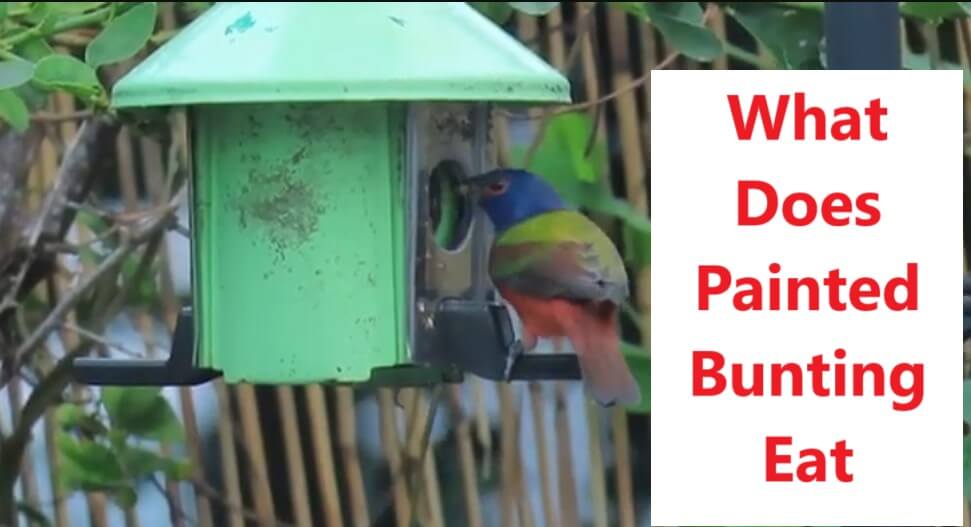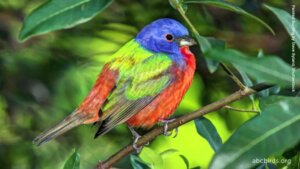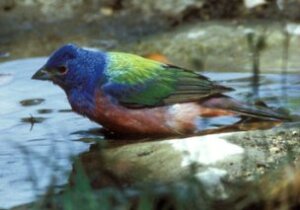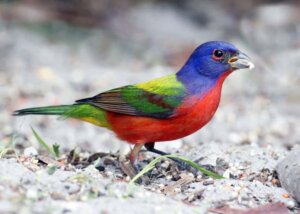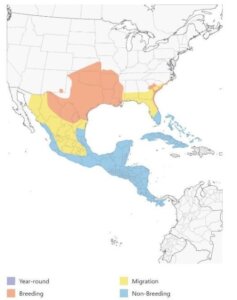What Does Painted Bunting Eat?
Painted Buntings are small, colorful birds. They are known for their bright, vibrant feathers.
What do these beautiful birds eat? Painted Buntings have a varied diet that helps them thrive in different environments. Their diet includes seeds, insects, and fruits. Understanding their eating habits can help bird watchers attract them to their gardens. It also provides insight into their role in the ecosystem.
Painted Buntings play a crucial part in controlling insect populations and spreading seeds. Knowing what they eat can make observing these birds even more enjoyable. Let’s explore the dietary preferences of the Painted Bunting in detail. This will help you attract and appreciate these stunning birds.

Credit: www.blog.catandturtle.net
Introduction To Painted Bunting
The Painted Bunting is a strikingly colorful bird. Its vibrant plumage makes it a favorite among bird watchers. Known for its elusive nature, this bird captures the hearts of many.
Overview Of The Species
The Painted Bunting belongs to the cardinal family. Males boast bright blue, green, and red feathers. Females and young birds display more subdued, yellow-green tones. These birds are small, typically 5-6 inches in length. They are known for their sweet, melodic songs.
Habitat And Distribution
Painted Buntings prefer brushy areas and woodland edges. They are often found in southeastern United States during breeding season. In winter, they migrate to southern Florida, the Caribbean, and Central America. They thrive in habitats that provide dense cover and abundant food sources.
Natural Diet
The Painted Bunting is a colorful bird with a varied diet. These birds thrive on a mix of insects and seeds. Their diet changes with the seasons and food availability. Let’s explore what these beautiful birds eat in the wild.
Insect Consumption
Painted Buntings consume a variety of insects. They hunt for bugs, beetles, and caterpillars. Insects provide essential proteins and nutrients. This diet is especially important during the breeding season. They need extra energy to care for their young.
- Beetles
- Grasshoppers
- Spiders
- Caterpillars
During summer, insects make up a large part of their diet. Painted Buntings use their keen eyesight to spot prey. They often catch insects on the ground or in low shrubs. This diet helps maintain their vibrant plumage.
Seed Preferences
Seeds are a major part of the Painted Bunting’s diet. They consume seeds from a wide range of plants. These seeds provide fats and carbohydrates. This helps the birds stay energetic and healthy. They prefer seeds from grasses and weeds.
| Plant | Seed Type |
|---|---|
| Ragweed | Small seeds |
| Sunflower | Large seeds |
| Switchgrass | Medium seeds |
| Sorghum | Grain seeds |
Painted Buntings prefer seeds from native plants. This natural diet helps them during the non-breeding season. They forage on the ground to find seeds. This behavior ensures they get enough food throughout the year.
Seasonal Dietary Changes
The Painted Bunting is a colorful bird known for its vibrant plumage. But did you know its diet changes with the seasons? These changes help it survive and thrive all year round. Let’s explore what the Painted Bunting eats in different seasons.
Spring And Summer Diet
In spring and summer, the Painted Bunting’s diet is rich in insects. It eats grasshoppers, beetles, and caterpillars. These insects provide protein for growth and energy. The bird also enjoys spiders and snails. Fresh fruits and seeds are part of its diet too. Berries and small seeds offer essential nutrients.
Fall And Winter Diet
During fall and winter, the Painted Bunting’s diet shifts. It eats more seeds than insects. Seeds from grasses and weeds become main food sources. The bird also eats grains and small berries. These foods help it stay warm and energized. In winter, insects are scarce. So seeds and berries are crucial for survival.

Credit: valleyfarms.shop
Feeding Behavior
The Painted Bunting is a small, colorful bird known for its vibrant plumage. Besides its beauty, its feeding behavior is quite fascinating. Understanding how it finds and consumes food can give us insight into its daily life.
Foraging Techniques
The Painted Bunting uses a variety of foraging techniques. It often searches for food in dense shrubs and low vegetation. This bird is mostly a ground feeder, picking seeds and insects from the ground. Sometimes, it hops from branch to branch, looking for ripe berries and small fruits. It also pecks at grass seeds and other plants.
Insects are a significant part of its diet, especially during the breeding season. The Painted Bunting eats caterpillars, beetles, and spiders. It catches these by swiftly moving through foliage. This bird’s sharp vision and quick reflexes make it an efficient forager.
Feeding Times
The feeding times of the Painted Bunting can vary. Typically, it is most active in the early morning and late afternoon. During these times, it searches for food vigorously. Midday is usually a resting period when the sun is hottest.
In the breeding season, Painted Buntings feed more frequently. They need extra energy for mating and caring for their young. During migration, they also feed heavily to build up fat reserves. This ensures they have enough energy for their long journey.
Impact Of Diet On Plumage
The Painted Bunting is a bird known for its vibrant colors. The diet of this bird has a significant impact on its plumage. Bright and healthy feathers indicate a well-balanced diet. This section will explore the nutritional influence and coloration variations in detail.
Nutritional Influence
A Painted Bunting’s diet mainly consists of seeds, insects, and fruits. These foods provide essential nutrients. For example, seeds are rich in proteins and fats. Insects offer vitamins and minerals. Fruits supply antioxidants and sugars.
| Food Type | Nutritional Benefit |
|---|---|
| Seeds | Proteins, Fats |
| Insects | Vitamins, Minerals |
| Fruits | Antioxidants, Sugars |
Good nutrition helps the bird maintain its colorful feathers. Poor diet leads to dull and weak plumage. Balanced meals are key for vibrant colors.
Coloration Variations
The colors of a Painted Bunting can vary based on diet. Males usually have blue heads, green backs, and red underparts. Females and young birds are greenish-yellow.
- Blue Head: Indicates a diet rich in proteins.
- Green Back: Shows a balance of fats and vitamins.
- Red Underparts: Reflects high antioxidant intake.
A diet lacking in essential nutrients can alter these colors. For example, a lack of proteins can make the blue head appear dull. Insufficient antioxidants can fade the red underparts. Monitoring the bird’s diet is crucial for maintaining its stunning colors.
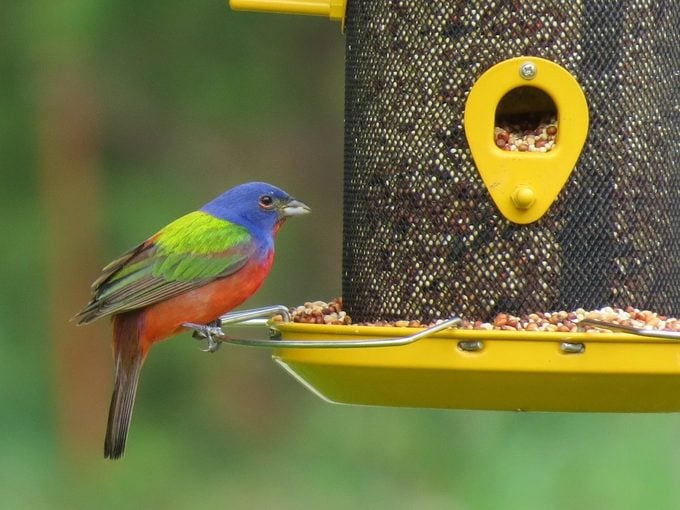
Credit: www.birdsandblooms.com
Feeding Painted Buntings In Captivity
Feeding Painted Buntings in captivity can be a delightful experience. These vibrant birds have specific dietary needs that must be met for their health and well-being. Providing a balanced diet ensures they thrive and display their beautiful plumage.
Recommended Foods
Painted Buntings enjoy a variety of seeds. Millet, sunflower, and safflower seeds are top choices. Fresh fruits like apples, berries, and oranges are good too. They also need protein. Offer mealworms and small insects. These are crucial for their diet.
Feeding Tips
Place food in shallow dishes. This makes it easy for the birds to eat. Keep dishes clean to avoid bacteria. Change water daily. Fresh water is essential for their health. Observe their eating habits. Adjust portions if needed. Ensure they have a balanced mix of seeds, fruits, and insects.
Provide cuttlebone or a mineral block. This helps with calcium intake. It is vital for their bones and eggshell strength. Place feeders in a quiet area. Painted Buntings get stressed easily. A calm environment helps them eat well and stay healthy.
Conservation And Diet
Painted Buntings are beautiful, colorful birds. Their diet and conservation status are crucial for their survival. Understanding their diet and the impact of environmental changes on their habitat is essential. This article explores the Painted Bunting’s diet and what we can do to protect them.
Habitat Preservation
Painted Buntings need a specific habitat to thrive. They live in brushy areas, thickets, and woodland edges. Protecting these habitats is vital. Without these areas, their survival becomes difficult. Conservation efforts focus on preserving these natural environments.
Efforts include planting native shrubs and trees. This creates a suitable habitat for them. It also helps other wildlife. Supporting organizations that protect these habitats can make a big difference.
Impact Of Environmental Changes
Environmental changes affect Painted Buntings’ diet and habitat. Deforestation and urban development are major threats. These activities destroy their natural habitats. Climate change also impacts their food sources and breeding areas.
Changes in weather patterns can reduce the availability of seeds and insects. This affects their diet and reproductive success. Conservation efforts must address these challenges. Restoring habitats and creating protected areas can help mitigate these impacts.
Frequently Asked Questions
What Do Painted Buntings Eat In The Wild?
Painted Buntings primarily eat seeds, particularly grass seeds. They also consume small insects and spiders, especially during breeding season.
Do Painted Buntings Eat Insects?
Yes, Painted Buntings eat insects. They especially consume insects and spiders during their breeding season for protein.
What Seeds Attract Painted Buntings?
Seeds that attract Painted Buntings include millet, sunflower seeds, and nyjer. They prefer small seeds, particularly grass seeds.
Do Painted Buntings Eat Fruit?
Yes, Painted Buntings sometimes eat fruit. They enjoy berries and small fruits, particularly when other food sources are scarce.
Conclusion
Painted Buntings enjoy a varied diet. They eat seeds, insects, and fruits. This diet helps them stay healthy and vibrant. Seeds are their main food source. Insects provide protein, especially during breeding season. Fruits add essential vitamins. These foods make Painted Buntings thrive in their habitats.
Observing these birds can be a delightful experience. You can attract them by offering seeds and fruits. Keep your garden bird-friendly to enjoy their beauty. Happy bird watching!
Hello Dear, I'm Poli Kolymnia, owner of many birds (including budgies).
With a deep passion for these feathered companions, I'm here to share my expertise and extensive knowledge on birds care.
My articles cover essential topics like diet, housing, care, and health, providing practical tips to help you create a happy and thriving environment for your birds.

